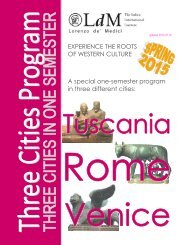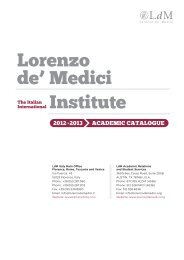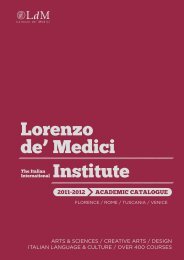aCademiC Catalog 2013-2014 - Lorenzo de Medici
aCademiC Catalog 2013-2014 - Lorenzo de Medici
aCademiC Catalog 2013-2014 - Lorenzo de Medici
Create successful ePaper yourself
Turn your PDF publications into a flip-book with our unique Google optimized e-Paper software.
School of Arts & Sciences ROME<br />
Anthropology<br />
Intercultural Communication<br />
ANT 290 R; Dual listed: COM 290 R<br />
Cr: 3; Contact hrs: 45<br />
The course, which introduces stu<strong>de</strong>nts to the basic patterns<br />
of cross-cultural psychology and communication, proposes<br />
an analysis of communication behavior in interpersonal and<br />
intercultural, individual and group environments. Along with a<br />
study of the influence of culture on i<strong>de</strong>ntity, viewpoints, and<br />
communication, it progressively proposes all the theoretical<br />
concepts that are necessary to analyze communication in<br />
an interpersonal and intercultural context. Topics inclu<strong>de</strong>:<br />
common communication difficulties, communication roles<br />
and proxemics. Special emphasis is placed on rituals, message<br />
patterns, clothing, myths, i<strong>de</strong>ologies, and on the influence of<br />
the mass media on our cross-cultural representation of reality.<br />
Prerequisites: Junior standing<br />
Archaeology and Classical<br />
Studies<br />
Un<strong>de</strong>rground Rome: The Christian Catacombs<br />
CLA 205 R<br />
Cr: 3; Contact hrs: 45<br />
The course aims to study and explore the darkest, <strong>de</strong>epest places<br />
beneath the city of Rome: there the still-extant un<strong>de</strong>rground<br />
web of galleries, shrines and basilicas built during the Early<br />
Christian and Early Medieval centuries (approx.150-900 CE).<br />
Thanks to a number of lectures and on-site classes, stu<strong>de</strong>nts will<br />
be able to un<strong>de</strong>rstand the birth and affirmation of the Christian<br />
religion in the capital city of the pagan Roman Empire. Study of<br />
archaeological sites and material culture are an essential part of<br />
the course, which inclu<strong>de</strong>s class visits to many sites including<br />
the Vatican necropolis beneath St. Peter’s, the catacombs of St.<br />
Sebastian, and the basilica of San Clemente.<br />
Ancient Rome<br />
CLA 210 R; Dual listed: HIS 200 R<br />
Cr: 3; Contact hrs: 45<br />
This course offers a comprehensive introduction to the history<br />
and growth of the ancient Roman empire from the early<br />
settlements in Latium, through the republican and imperial<br />
periods, to the formation of a new Roman world after the crisis<br />
of the 3rd century. A series of themes and issues will be explored:<br />
the range of primary sources available for ancient history;<br />
the political organization of the Roman state; the territorial<br />
expansion and its influence on the cultural and administrative<br />
sphere; Roman religion and the spread of Christianity; the<br />
Roman frontiers and the barbarian populations; and the end<br />
of the Roman world and the birth of a new society. In or<strong>de</strong>r<br />
to stimulate stu<strong>de</strong>nts’ critical skills in observing historical<br />
phenomena, a problem-oriented approach will be supported<br />
by readings of primary sources. Stu<strong>de</strong>nts will also have the<br />
chance to observe different approaches to un<strong>de</strong>rstanding<br />
the past and will <strong>de</strong>velop a sense of the role of historians and<br />
history in society.<br />
Introduction to Archaeology<br />
CLA 240 R<br />
Cr: 3; Contact hrs: 45<br />
Archaeology attempts to un<strong>de</strong>rstand humankind through the<br />
study of physical remains of past civilizations. This course<br />
introduces stu<strong>de</strong>nts to the aims, methods and possibilities<br />
of archaeological work, from the field to the museum,<br />
exploring past and recent theories and approaches to the<br />
discipline. Key issues in the practice of mo<strong>de</strong>rn archaeologists<br />
are examined, some through case studies. Topics inclu<strong>de</strong><br />
excavation, stratigraphy, cleaning and preservation, dating<br />
methods and protection of cultural heritage. Stu<strong>de</strong>nts study<br />
how archaeologists refer to other disciplines including history,<br />
cultural and physical anthropology, and art history. The course<br />
consi<strong>de</strong>rs contexts of both ancient Mediterranean and Near<br />
Eastern archaeology, from Prehistory to the Roman Empire,<br />
and inclu<strong>de</strong>s visits to museums and archaeological sites.<br />
Reading Ancient Rome: Literature, the City<br />
and Society<br />
CLA 284 R; Dual listed: LIT 284 R<br />
Cr: 3; Contact hrs: 45<br />
This course aims to offer stu<strong>de</strong>nts a first acquaintance with<br />
the riches of ancient Roman literature through analysis of<br />
a variety of texts in English translation. Through site visits in<br />
Rome stu<strong>de</strong>nts will have the chance to link their experience of<br />
ancient writings to direct observation of ancient monuments<br />
and art objects. The approach to the texts will be thematic: the<br />
full range of Latin literature from the pre-literary Carmina to<br />
the late Christian apologists will be covered in four thematic<br />
sections entitled Love, Power, Social Life and Religion.<br />
Exposure to different kinds of primary materials (literary texts,<br />
buildings and artworks) will encourage stu<strong>de</strong>nts to reflect on<br />
the links between changes in society (broadly conceived) and<br />
literary and aesthetic taste in ancient Rome. The course thus<br />
hopes to lead stu<strong>de</strong>nts towards a richer and more profound<br />
un<strong>de</strong>rstanding of the city in which they will be staying; an<br />
appreciation of the pleasures of reading ancient texts; and an<br />
insight into the complexities involved in reconstructing the<br />
historical past.<br />
Archaeology of Italy: from Constantine to<br />
Charlemagne<br />
CLA 298 R<br />
Cr: 3; Contact hrs: 45<br />
Once dismissed as the “Dark Ages” of invasion and <strong>de</strong>struction<br />
between the fall of ancient Rome and the rise of the medieval<br />
communes, the period has become the focus of intense<br />
scholarly activity and <strong>de</strong>bate. Thanks to excavations in towns,<br />
villas, cemeteries, churches and castles, a vastly more dynamic<br />
picture has emerged for Italy from Late Antiquity and the Early<br />
Middle Ages (circa 300-1000 CE). Exploiting new data and<br />
finds, together with secondary studies and literary sources,<br />
this course offers an overview of the archeological evi<strong>de</strong>nce<br />
and history of one of the most vital and complex periods in<br />
all European history. The stress is on continuity and major<br />
changes that occurred in the peninsula after the collapse of<br />
the Western Roman Empire. The medieval remains in Rome<br />
and northern Latium are outstanding. Course topics inclu<strong>de</strong>:<br />
archaeology of various typologies (domestic, settlements,<br />
churches, monasteries, burials, <strong>de</strong>fensive structures); specific<br />
cultures (Ostrogoths, Lombards); inscriptions; conservation<br />
and reconstruction; distinctive object types; basic analytical<br />
methods of various materials (pottery, metal, glass, wood,<br />
stone). Activities inclu<strong>de</strong> visits to museums in Rome and<br />
Tuscania (special laboratory), and to two excavation sites.<br />
Greek and Roman Mythology<br />
CLA 310 R<br />
Cr: 3; Contact hrs: 45<br />
The traditional stories about the Greek gods and heroes have<br />
always been a fundamental part of Western art and literature,<br />
especially since their “rediscovery” by Renaissance humanism.<br />
A selection of the great works of ancient Greek literature will<br />
present the most important stories, and will also show how the<br />
Greeks used myth to express the traditional i<strong>de</strong>als and personal<br />
reflections that captivated and shaped subsequent European<br />
culture. The pictorial narratives, so common in Greek and Roman<br />
monuments and objects, will introduce the sophisticated visual<br />
language created by the Greeks to tell such elaborate tales,<br />
the first such iconographic system and one which was to some<br />
extent “revived”, together with the gods, heroes and heroines,<br />
in Renaissance art. To know Roman mythology and un<strong>de</strong>rstand<br />
its similarities and differences with Greek mythology is to<br />
un<strong>de</strong>rstand the real essence of the i<strong>de</strong>als and aspirations of a<br />
great people that built a great empire. In particular, Virgil and<br />
Ovid, the most wi<strong>de</strong>ly known writers of Roman mythology, and<br />
also other Roman writers, will help stu<strong>de</strong>nts <strong>de</strong>velop a new<br />
interest for Roman myth, history and art.<br />
Art and Architecture of Ancient Rome<br />
CLA 318 R; Dual listed: ART 315 R<br />
Cr: 3; Contact hrs: 45<br />
This upper level course examines the major <strong>de</strong>velopments in the<br />
art and architecture of ancient Rome from the foundation of the<br />
132<br />
LdM Aca<strong>de</strong>mic <strong>Catalog</strong> <strong>2013</strong>-<strong>2014</strong>





